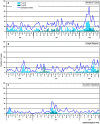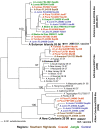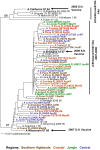Influenza-like illness sentinel surveillance in Peru
- PMID: 19568433
- PMCID: PMC2700970
- DOI: 10.1371/journal.pone.0006118
Influenza-like illness sentinel surveillance in Peru
Abstract
Background: Acute respiratory illnesses and influenza-like illnesses (ILI) are a significant source of morbidity and mortality worldwide. Despite the public health importance, little is known about the etiology of these acute respiratory illnesses in many regions of South America. In 2006, the Peruvian Ministry of Health (MoH) and the US Naval Medical Research Center Detachment (NMRCD) initiated a collaboration to characterize the viral agents associated with ILI and to describe the clinical and epidemiological presentation of the affected population.
Methodology/principal findings: Patients with ILI (fever > or =38 degrees C and cough or sore throat) were evaluated in clinics and hospitals in 13 Peruvian cities representative of the four main regions of the country. Nasal and oropharyngeal swabs, as well as epidemiological and demographic data, were collected from each patient. During the two years of this study (June 2006 through May 2008), a total of 6,835 patients, with a median age of 13 years, were recruited from 31 clinics and hospitals; 6,308 were enrolled by regular passive surveillance and 527 were enrolled as part of outbreak investigations. At least one respiratory virus was isolated from the specimens of 2,688 (42.6%) patients, with etiologies varying by age and geographical region. Overall the most common viral agents isolated were influenza A virus (25.1%), influenza B virus (9.7%), parainfluenza viruses 1, 2, and 3, (HPIV-1,-2,-3; 3.2%), herpes simplex virus (HSV; 2.6%), and adenoviruses (1.8%). Genetic analyses of influenza virus isolates demonstrated that three lineages of influenza A H1N1, one lineage of influenza A H3N2, and two lineages of influenza B were circulating in Peru during the course of this study.
Conclusions: To our knowledge this is the most comprehensive study to date of the etiologic agents associated with ILI in Peru. These results demonstrate that a wide range of respiratory pathogens are circulating in Peru and this fact needs to be considered by clinicians when treating patients reporting with ILI. Furthermore, these data have implications for influenza vaccine design and implementation in South America.
Conflict of interest statement
Figures






References
-
- Monto AS. Epidemiology of viral respiratory infections. Am J Med. 2002;112(Suppl 6A):4S–12S. - PubMed
-
- Williams BG, Gouws E, Boschi-Pinto C, Bryce J, Dye C. Estimates of world-wide distribution of child deaths from acute respiratory infections. Lancet Infect Dis. 2002;2:25–32. - PubMed
-
- McMillan JA, Weiner LB, Higgins AM, Lamparella VJ. Pharyngitis associated with herpes simplex virus in college students. Pediatr Infect Dis J. 1993;12:280–284. - PubMed
-
- Portes SA, Da Silva EE, Siqueira MM, De Filippis AM, Krawczuk MM. Enteroviruses isolated from patients with acute respiratory infections during seven years in Rio de Janeiro (1985–1991). Rev Inst Med Trop Sao Paulo. 1998;40:337–342. - PubMed
-
- World Health Organization. Influenza Fact Sheet. 2003. Available: http://www.who.int/mediacentre/factsheets/fs211/en. Accessed 2007 Oct 30.
Publication types
MeSH terms
Substances
LinkOut - more resources
Full Text Sources
Medical

